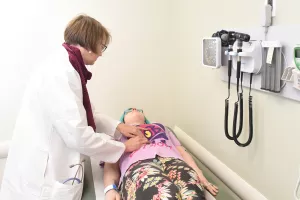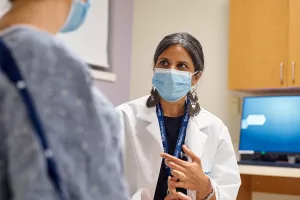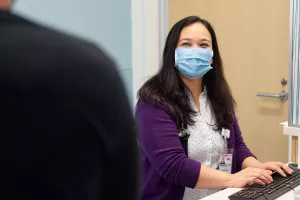Esophageal motility refers to the muscle movement of your esophagus — the tube that carries food and liquid from your throat to your stomach. Diseases like gastroesophageal reflux disease (GERD) and achalasia (trouble swallowing) affect your esophagus’ functionality and cause symptoms like heartburn and acid reflux.
Soothing care for acid reflux
From work lunches to family dinners and neighborhood potlucks, food plays a big part in how we connect with each other. When gastroesophageal diseases start impacting how we eat and digest, they can take a toll on our quality of life.
If symptoms like heartburn and acid reflux are holding you back from enjoying these moments, then a little something different is just what the doctor ordered. Our goal is to help you enjoy foods rather than worry about their after effects.

Conditions
Esophageal motility disorders like achalasia, GERD and heartburn affect how food travels from your mouth, down the esophagus and into your stomach. It's because the muscles in the esophagus don't work like they should. This disorder can interfere with your eating and digestion, causing uncomfortable and sometimes painful symptoms.
Achalasia
Achalasia is an esophageal disorder where food doesn’t move from your mouth to your stomach properly. It occurs when nerves in your esophagus and lower esophageal valve are damaged or destroyed, taking a toll on your esophagus's healthy movements.
Common achalasia symptoms to be on the lookout for include:
- Chest pain
- Coughing or choking during meals
- Difficulty swallowing solids and liquids
- Feeling of food getting stuck in your throat or chest
- Heartburn
- Uncontrolled regurgitation of undigested food
- Vomiting after or while eating
- Weight loss
Gastroesophageal reflux disease (GERD)
GERD is one of the most common esophageal motility disorders, affecting about 20% of Americans. It happens when your lower esophageal sphincter (LES) weakens, allowing stomach acid to enter your esophagus.
GERD isn’t life-threatening, but it can cause intense pain, interfere with eating, inflame the esophagus or cause scarring of the esophagus.
It’s a good idea to seek help from a doctor if you’re living with any of these common GERD symptoms:
- Bad breath
- Chest pain or discomfort
- Chronic dry cough, especially at night
- Feeling like there’s a lump in your throat
- Hoarseness or sore throat
- Laryngitis
- Recurring heartburn, especially after meals
On the other hand, it’s possible to have GERD without any noticeable symptoms.
Heartburn
Heartburn is a painful burning feeling in the chest or throat. It occurs when stomach acid backs up into your esophagus. This is a more mild symptom of acid reflux, compared to its more intense counterpart, GERD.
Testing
To determine the cause of your symptoms, our team may recommend an esophageal motility study to check the esophagus for abnormal movements.
You can rest assured that this is a fairly quick and very safe procedure. We kick off the study by numbing the nose. This is to help you feel more comfortable as we pass a catheter (a narrow tube) roughly the size of a thick spaghetti strand through one nostril, down the back of the throat and into the esophagus. We’ll ask you to swallow as we thread the catheter into place.
The catheter is lined with tiny sensors that measure the squeeze of the upper esophageal sphincter (UES) and lower esophageal sphincter (LES). These sphincters are like automatic doors:
- Sphincters remain closed until they sense food or liquid moving toward them.
- The sphincters relax and open for the food and liquid to pass through the esophagus (UES) and into the stomach (LES).
To evaluate the squeeze of your UES and LES, you’ll be asked to swallow about one teaspoon of water at a time so your doctor can record and analyze the muscle movements.
Additional testing for esophageal motility disorders
We use a 24-hour PH impedance monitoring test to measure the amount of acid reflux or “back up” from the stomach into the esophagus. This test involves placing a catheter into the base of the esophagus for 24 hours. It will track and record your meals, sleep and symptoms for your doctor to analyze.
High-resolution manometry is a specialized swallow study that measures the your esophagus's pressure at rest and when actively swallowing. These measurements will indicate if your esophagus is working properly or if we need to explore further testing and treatment.
An upper gastrointestinal (GI) endoscopy is a type of exam doctors use to evaluate the 3 main parts of your upper GI tract:
- Duodenum (first part of the small intestine)
- Esophagus
- Stomach
You can expect to receive medication before the exam to help you feel more comfortable. Most people even doze off into a light sleep. Because of this, you’ll need someone 18 years or older to get you home safely on the day of your exam.
This involves drinking a barium solution followed by a series of X-rays of your upper digestive system. The barium solution illuminates your digestive system like a highlighter, producing clearer pictures on the X-rays.
Treatments
Together, we'll create a personalized treatment plan for GERD or achalasia, ranging from short-term fixes to more lasting solutions.
Treating GERD
In many cases, we can treat GERD with medication that neutralizes the stomach acids. If this medication doesn’t relieve your symptoms, or if you prefer to not take daily medications, surgery may be the right treatment option for you.
A Nissen fundoplication surgery is a 2-hour procedure with a quick recovery time. First, we’ll use a minimally invasive technique called a laparoscopy to make small incisions that we’ll guide medical instruments and cameras through.
To perform the Nissen fundoplication, we’ll wrap a part of your stomach around both sides of your esophagus and secure it in place. This will restore normal pressure to your lower esophageal sphincter (LES).
Following the surgery, you'll likely spend only 1 night in the hospital with us. And as you heal, we'll switch you to a liquid diet for a few weeks. It's a short adjustment for a smoother recovery because the end result is enjoyable, pain-free eating.
Treating achalasia
We can treat achalasia with endoscopic therapies or surgery. Endoscopic therapies like pneumatic dilation or Botox injections can offer relief from symptoms for only a little while. Plus, you'll need multiple treatments to keep symptoms temporarily at bay.
Surgery can be a more permanent solution for your your condition.
People who choose to go the Botox route will need regular injections to alleviate their symptoms.
Pneumatic dilation uses a balloon or guidewire to open your esophagus. We’ll use a long, flexible tube with scope to insert either one of these tools into your esophagus:
- Balloon
- Guidewire into your esophagus
Then, we’ll carefully expand the balloon or slide a tool over the guidewire. You may feel some pressure in your esophagus during the procedure.
Afterward, we’ll take out the tube and balloon or guidewire tool. You may need this procedure done several times to help open the narrow part of your esophagus.
Laparoscopic Heller myotomy surgery is a minimally invasive method for opening the LES to relieve difficulty swallowing. It involves making several small incisions in the abdomen that we insert tiny medical instruments and a camera through.
These tools guide the doctor as they cut through the muscular layer of the lower end of the esophagus and the upper area of the stomach. This type of surgery is also known as a myotomy.
We can also address gastric reflux during this procedure using a process called fundoplication. To prevent acid from rising into the esophagus, we wrap a part of the stomach around the esophagus.

From regular office visits to inpatient stays, find the healthcare you need and deserve close to home.

Meet the doctors and care team devoted to supporting you every step of the way along your path to better health.